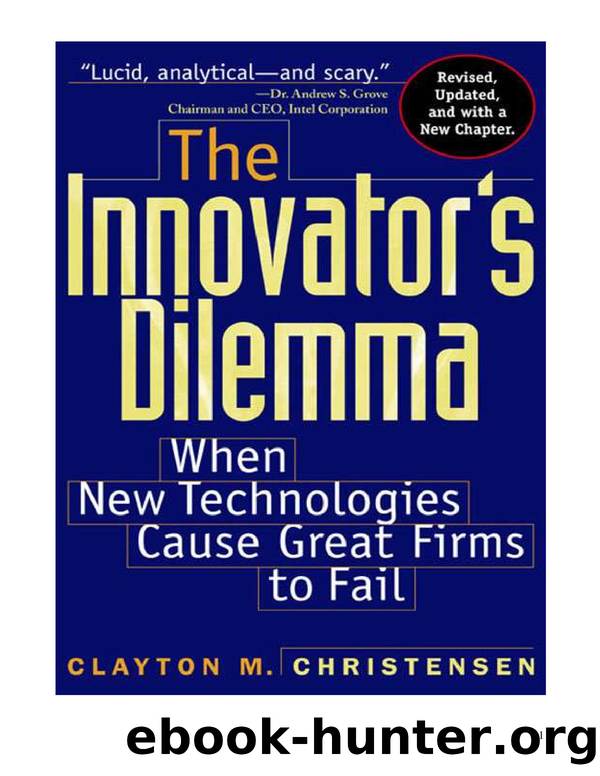The Innovator's Dilemma by Clayton M. Christensen

Author:Clayton M. Christensen
Language: eng
Format: mobi
Published: 2012-01-14T07:44:18+00:00
The first discount store was Korvetteâs, which began operating a number of outlets in New York in the mid-1950s. Korvetteâs and its imitators operated at the very low end of retailingâs product line, selling nationally known brands of standard hard goods at 20 to 40 percent below department store prices.
They focused on products that âsold themselvesâ because customers already knew how to use them.
Relying on national brand image to establish the value and quality of their products, these discounters eliminated the need for knowledgeable salespeople; they also focused on the group of customers least attractive to mainstream retailers: âyoung wives of blue collar workers with young children.â9 This was counter to the upscale formulas department stores historically had used to define quality retailing and to improve profits.
Discounters didnât accept lower profits than those of traditional retailers, however; they just earned their profits through a different formula. In the simplest terms, retailers cover their costs through the gross margin, or markup, they charge over the cost of the merchandise they sell. Traditional department stores historically marked merchandise up by 40 percent and turned their inventory over four times in a yearâthat is, they earned 40 percent on the amount they invested in inventory, four times during the year, for a total return on inventory investment of 160 percent. Variety stores earned somewhat lower profits through a formula similar to that used by the department stores. Discount retailers earned a return on inventory investment similar to that of department stores, but through a different model: low gross margins and high inventory turns. Table 5.1 summarizes the three positions.
Table 5.1 Different Pathways to Profits
Calculated as Margins x Turns, in other words, the total of the margins earned through successive turnovers each year.
Source: Annual corporate reports of many companies in each category for various years.
The history of discount retailing vividly recalls the history of minimill steel making. Just like the minimills, discounters took advantage of their cost structure to move upmarket and seize share from competing traditional retailers at a stunning rate: first at the low end, in brand-name hard goods such as hardware, small appliances, and luggage, and later in territory further to the northeast such as home furnishings and clothing. Figure 5.2 illustrates how stunning the discountersâ invasion was: Their share of retailing revenues in the categories of goods they sold rose from 10 percent in 1960 to nearly 40
percent a scant six years later.
96
Download
This site does not store any files on its server. We only index and link to content provided by other sites. Please contact the content providers to delete copyright contents if any and email us, we'll remove relevant links or contents immediately.
The Data Detective by Tim Harford(949)
Mind Management, Not Time Management by David Kadavy(623)
100 Tricks to Appear Smart in Meetings by Sarah Cooper(601)
GMAT For Dummies 2021 by Lisa Zimmer Hatch & Scott A. Hatch(589)
Amazing Decisions by Dan Ariely(493)
The Smart Strategy Book by Kevin Duncan(434)
The Data Science Framework by Unknown(417)
99 Financial Terms Every Beginner, Entrepreneur & Business Should Know (Financial IQ Series Book 1) by Herold Thomas(397)
The Store Detective Training Manual: A Practical Reference for Current and Aspiring Loss Prevention Officers by Glen Canarte(373)
Poor Students, Rich Teaching by Eric Jensen(334)
Robert's Rules of Order by Henry M. Robert(332)
Side Hustles: How to Make Extra Money Online by Hayden Vernon(309)
Arts, Sciences, and Economics by Tönu Puu(307)
97 Things Every Information Security Professional Should Know by Christina Morillo(304)
Cambridge IGCSE and O Level Business Studies by Karen Borrington(298)
Sustainable Education and Development by Unknown(297)
Excel 2016 for Marketing Statistics by Thomas J. Quirk & Eric Rhiney(293)
Enterprise Analytics by Thomas H. Davenport(289)
Information Literacy in Higher Education by unknow(281)
